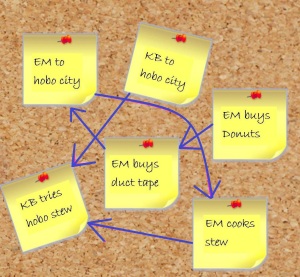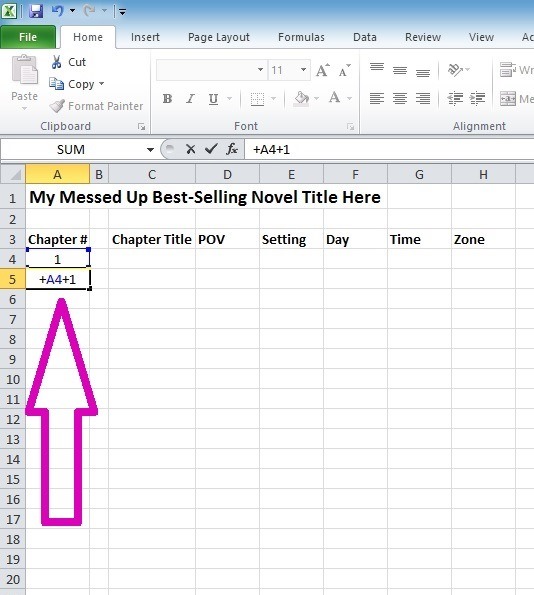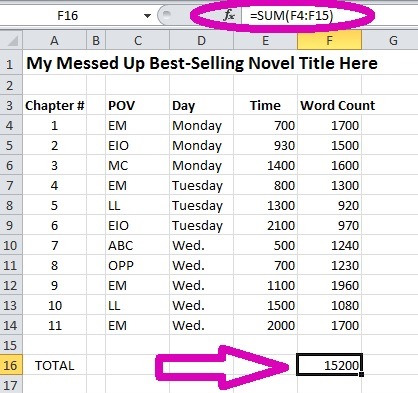 Ever be cranking along on your work-in-progress (WIP) without a care and suddenly realize that your timeline is all discombobulated? Juggling numerous characters with a different point of view (POV) in each chapter has finally caught up with you. Don’t you hate it when that happens? I know I do.
Ever be cranking along on your work-in-progress (WIP) without a care and suddenly realize that your timeline is all discombobulated? Juggling numerous characters with a different point of view (POV) in each chapter has finally caught up with you. Don’t you hate it when that happens? I know I do.
This kind of thing is bound to occur, especially if you have characters who whisk off to far-away lands – which means you need to incorporate the gaps created by lengthy air travel as well as time zone changes. What a mess!
Here’s a handy little tip for you which costs nothing. In fact, it’s so simple that it may strike you as stupid initially, but sometimes simplifying is exactly what’s needed when a project goes out of control.
Not only will this help you put your book in a linear context, it will also help you catch duplicate chapter numbers, chapters missing titles (if you use them), chapters with inconsistent POVs, gaps in time, overlaps in time, and even, possibly, loose ends. Okay, okay, I’ll get to it already. All it is – is a simple spreadsheet. I know no one told you there would be math involved, but it’s okay. The only math you really need to know is how to read a clock. Is that even math?
Open your spreadsheet program. I use MS Excel 2010. Now, I’m using a spreadsheet instead of a table in a word processing document because it’s easier to sort and move things around. And, if you decide you need an extra column or row, you’ve already got it at your disposal instead of having to create more. It’s just simpler.
 Put in the title of your book and create whatever columns you think you’ll need. Again, the beauty of a spreadsheet is that it’s so easy to add, delete, and move rows and columns if you feel you need to – so it’s no sweat if you realize you need more as you go along. Add your chapter numbers under that column. Hint: you don’t have to type them all in. Just do a simple formula using the cell above it +1, hit copy, and paste it down as far as you want – and voila! All your chapter numbers. I personally don’t title my chapters, but I thought that might be useful to some – so that’s in column two. It’s my first time writing a book with multiple POVs, so I want to track and make certain I don’t accidentally have the same character’s POV two chapters in a row. Setting can be important if you have your character in Seattle in the morning and twenty minutes later, he or she is in Boston. What?! And, of course, if you have some characters in England and some in Vancouver, that’s going to be make a difference time zone-wise.
Put in the title of your book and create whatever columns you think you’ll need. Again, the beauty of a spreadsheet is that it’s so easy to add, delete, and move rows and columns if you feel you need to – so it’s no sweat if you realize you need more as you go along. Add your chapter numbers under that column. Hint: you don’t have to type them all in. Just do a simple formula using the cell above it +1, hit copy, and paste it down as far as you want – and voila! All your chapter numbers. I personally don’t title my chapters, but I thought that might be useful to some – so that’s in column two. It’s my first time writing a book with multiple POVs, so I want to track and make certain I don’t accidentally have the same character’s POV two chapters in a row. Setting can be important if you have your character in Seattle in the morning and twenty minutes later, he or she is in Boston. What?! And, of course, if you have some characters in England and some in Vancouver, that’s going to be make a difference time zone-wise.
 Other things you can track using the spreadsheet include, but are not limited to, chapter word count (if you care about them being of comparable length), key conflict (helpful when writing your book description), or whatever else suits your fancy. The cool thing about inputting chapter word count is that you can quickly and easily total your book’s length and chart your progress. Now, I know that most word processing programs will give you a word count total – but that’s only if you write your book in ONE document. Since I write out of order (I know a lot of authors do), I tend to make a different document for each chapter. This way, I can easily see how far along I am in the book.
Other things you can track using the spreadsheet include, but are not limited to, chapter word count (if you care about them being of comparable length), key conflict (helpful when writing your book description), or whatever else suits your fancy. The cool thing about inputting chapter word count is that you can quickly and easily total your book’s length and chart your progress. Now, I know that most word processing programs will give you a word count total – but that’s only if you write your book in ONE document. Since I write out of order (I know a lot of authors do), I tend to make a different document for each chapter. This way, I can easily see how far along I am in the book.
I found this technique particularly useful when I was writing Lust for Danger, when Special Agent Night was chasing bad guys across time zones and I was working full-time so I only had a few hours a night to write. Having something which helped me keep organized and showed my progress was invaluable. How would you use it?

gee, I just write each story line separately, in a separate file, and collate them later
I use Excel in similar ways. Thanks for the article!
Good info. With my Dragonslayer’s Saga, I just used a Word doc and made chapter headings with entries as to what day, time, and what my characters were doing. That proved helpful and kept me on track for timing. I can also use different colors of highlighting to differentiate sub-plots and important events. When I get done, I have a rainbow that makes sense.
Oooh, spiffy. I usually go old school: white index cards and highlighters.
Cool idea. I haven’t needed to go this complex yet (I just jot down notes at the end of my WIP file and in my associated ‘notes’ file), but now I want to do this.
Brilliant! I use pen and paper to do the same thing. This is so much more new school and has several advantages over my old school ways. I’m so going to try this!
I have just died and gone to spreadsheet heaven. Why have I never thought of this? I have a spreadsheet for everything and now I’ll have one more. THANKS!
Glad you like it!
Say…I could use Excel to keep track of my NaNo word count, instead of writing it on a Post-it and doing the addition on my phone calculator. Why didn’t I think of that?
I’m going to keep the rest of this in mind for whatever my next project ends up being. Hmm, I wonder if you can import a functioning spreadsheet into OneNote?
I have OneNote but I have no idea what it is LOL.
I found a cool app called Evernote. Wonder if it’s similar. It’s like a bunch of sticky notes that don’t fall off the table and get covered with fuzz.
Girl, I just graduated from stone tablets to Excel. Don’t confuse me with fancy newfangled gizmos.
Sure you do! Look right here: https://indiesunlimited.com/2013/01/25/juggling-books-in-a-series/

The answer to my question is yes, you can embed an Excel spreadsheet into a OneNote notebook — *if* you have Office 2013. Sigh.
EXCEL RULES. Thanks for the post, KS!
I love Excel and I am glad you shared this.
This might also help some others regarding the point of view (POV) and columns. If you set up a column for each point of view character and put a ‘1’ in the column, you can total the chapters to see how many chapters have been written for each character.
What is nice about that is you can easily eyeball those columns to see how they ping-pong against one another.
To your point about number of words per chapter – you can total those easily and then divide by the total chapters to get an average words per chapter.
I also like to put highlights of the chapter, and a few other things. However, I still need to go back to read what I wrote. I found a nice method of sending my draft manuscript to my Kindle to read the night before I commence writing again.
If anyone would like to see what this looks like, please send me an email (dickcwaters@gmail.com) and I will send you a copy of my current in process novel’s spreadsheet. [A picture is worth a thousand words.]
I use a spreadsheet to plan out where and when each scene takes place for the first draft. My first pass through for revision is to tighten up the timeline. What I find interesting is that often the actual time passing doesn’t need to be put in the story, but I need to know so that someone isn’t eating dinner 2x in one day. The errors are what jump out to the reader.
I love my spreadsheets.
Spreadsheets rock, don’t they?
Excel is such a great tool for so many things. Hadn’t considered this as an organizing option. Thanks so much for sharing
You’re very welcome! Glad it’s helpful.